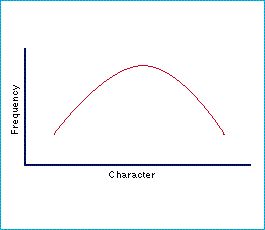Quantitative genetics - What has driven the evolution of beak sizes in Darwin's finches?

Two important points about the beak size of Galapagos finches:
• It shows continuous variation. Simple Mendelian characters, like blood groups or the mimetic variation of Papilio , often have discrete variation: but many of the characters of species are like beak size in these finches; they vary continuously, and every individual in the population differs slightly from every other individual. There are no discrete categories of beak size in G. fortis or in most other species of birds.
• We do not know the exact genotype that produces any given beak size. We can, however, say something about the general sort of genetic control it may have. Characters like beak size, which has a normal frequency-distribution (i.e., a bell curve), are probably controlled by a large number of genes, each of small effect. Why is this?
Figure: the bell curve shape appears again and again in graphs which measure frequency distribution.
| Next |



